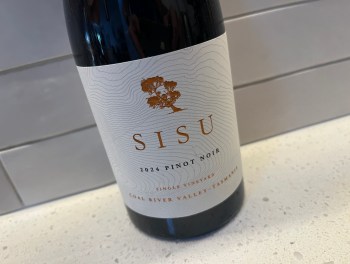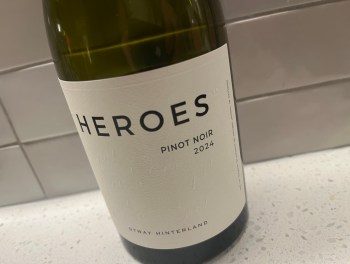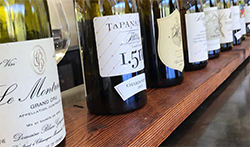3 faces of the Grampians
With an unbroken wine history dating back to 1862, the Grampians has no shortage of vinous kudos. Yet, as a wine region it’s in something of a state of flux, with a winemakers association that is being torn apart by internal politics, amidst a generally fragmented community of vignerons.
In this post then I’m going to look – from slightly different angles – at three different Grampians wine producers that I visited last weekend, all with much vested in the region and all producing valid Grampians styles. Hopefully what comes out is a small snapshot of some of the ‘faces’ of this quietly magnificent wine region.
Mt Langi Ghiran
 |
| Mount Langi Ghiran cellar door. Stunning |
The picture (left) is just one scene from what has to be one of the more dramatic sites in Australian wine.
Mount Langi Ghiran (the estate) is built into the side of it’s namesake: a dramatic granite outcrop sitting near the north eastern boundary of the Grampians region. With a viticultural history that dates back to the 1870s (though with a gap of 75 odd years from the late 1890s to the early 1960s) Mount Langi Ghiran can rightly claim a stake as one of the more important/famous wine producers of the region.
Fittingly, the Mount Langi cellar door itself (as depicted in the photo above/left) is a striking place: Modern, well integrated and set to a stunning backdrop. Striking too, as Mount Langi is an isolated part of the world, in both wine and geographical terms, with the constant winds and spooky looking mountain all making for what is quite a stark – and almost unfriendly – setting.
The whole estate, from a wine point of view, looks special, suggesting that there should be special wine produced here. In all honesty, however, I came away disappointed.
The biggest disappointment lies at the cellar door. For what is a somewhat remote place (45 minutes from anywhere) the range of wines on for tasting is sparse, with only a small selection of the mid priced wines available to sample at the cellar door. I well understand the challenges of quiet cellar doors (and many other Grampians/Pyrenees producers do even more so) but to turn up at such a stunning location, in rural Victoria, and only get to taste a mere sniff of what the site can do feels like a slap in the face. If Langi are worried about wastage, or bus tours or whatever, charge a $5 (or even $10 to taste the top wine) tasting fee to cover costs. I certainly would have paid it.
As if to prove the point, A 2003 Langi Shiraz also consumed over the weekend was suitably dried out, forward and lacking in enough fruit to keep up with the structure, further emphasising the problems of such excesses.
(Would be interested to hear other opinions on this. Also interested to try the new 07 and 08 vintage Langi Shiraz – perhaps the balance has been restored?).
I really quite enjoyed this. Textural, long and succulent Pinot Gris with pear and honey on a crisp and quite long backbone. Nice wine. Plenty of appeal here.
Clayfield
For behind the trademark moustache – and ability to talk underwater – lies a highly experienced winemaker, one who has almost 25 Grampians vintages (many of which were served at Best’s) under his belt and a whole network of local grower contacts to call on.
That last bit is important, for Simon’s own Clayfield vineyard is just 13 years old, and has had only a handful of commercial harvests in that time, due mainly to problems with drought and bushfire. Instead, it has been several old vineyards – notably the Robinson vineyard on Mt Ararat – that have provided the backbone for the Clayfield wines.
Now Simon, like many of the regions producers, concentrates on Shiraz. In fact, besides a token Pyrenees Sauvignon Blanc, all he makes is Grampians Shiraz. As a result, and given some of the success/critical acclaim his wines has enjoyed over the years, you could call him a Grampians Shiraz expert.
Little wonder then that his wines show the regional style with aplomb. Even in 2008 – which produced plenty of seriously big, alcoholic wines – the regional spiciness is present (though I’m not a massive fan of the two 08 Shiraz, which are just too ripe for me) and the wines taste balanced.
Still, don’t come here looking for elegance, for whilst the alcohol doesn’t generally stand out (08’s excepted), the wines are built unashamedly lavish (but in a good way).
The wine highlights:
Clayfield Shiraz 1999
A back vintage curio, this was one of Simon’s first wines and it was looking in very good shape. Big, still quite firm and dense, with layer upon layer of spicy fruit. Pepper, both black and white, and no shortage of it either. Lovely.
Clayfield Shiraz 2006 ($45)
Take the above wine and subtract 7 years. It’s probably not as spicy as the 1999 – and not likely to end up that way either – but entirely enjoyable in a more luscious style. It’s all about purple plum fruit and no shortage of viscous warmth, but still with solid fruit tannins and a firm line through the finish. Good stuff. Tasty.
Best’s
 |
| 140 year old Pinot Meunier and Pinot Noir vines |
Arguably the leading producer in the Grampians (particularly thanks to the wane of Seppelt’s star post Fosters takeover), you can’t talk about this part of the world without focusing on the (resurgent) Best’s.
I won’t bore you with this wineries history (it’s all here) but suffice to say that Trevor Mast (who owned Langi up until recently) made wine here in the 70’s/mid 80’s and Simon Clayfield made wine here in the late 80’s/mid 90’s, making Best’s particularly pertinent to this story.
What I really want to focus on though is the more recent history. For Best’s, like many successful family wine companies, has basically reinvented itself in recent years, simplifying themselves even.
You can see the results of this process at the winery itself – witness, for example, the large scale, multi thousand litre tanks that sit out next to the winery shed. If you were to take a peak inside these tanks you’d notice that they no longer hold wine and are now full of water. The large airbag presses don’t get much work these days either, with small batches and basket presses utilised for much of the top wines.
Similarly, at cellar door, the cheaper ‘Victorian’ range is being gradually phased out as the ‘Great Western’ range takes more prominence, the winery in effect dragging their whole persona back to where it started at sleepy Great Western.
It’s a smart move – or at least I think so – from a marketing perspective, particularly given that ‘Great Western’ is one of only two specific subregions in Victoria (along with the Nagambie Lakes in the Goulburn Valley), making the area itself even more unique/special.
Wine wise, the ‘Great Western’ range has had some new releases of late too, including a lauded Sparkling Shiraz – that they can’t produce enough of – and a young vine Pinot Meunier. Upcoming additions include a single block 2010 Riesling (which I can confirm is particularly interesting) and a Cabernet blend from some of the oldest Cabernet vines on the Concongella vineyard.
It’s all very positive indeed.
The only challenges for Best’s now is what to do with the – now 80 year old – St Andrews vineyard at Lake Boga (near Swan Hill). What do you do with a major vineyard asset, that now produces grapes that cost more to pick than they do to produce? What a quandary….
The wine highlights
Best’s Bin 0 Great Western Shiraz 1997
Delicious stuff. I believe that it was Campbell Mattinson that talked of ‘plum essence’ as the quintessential Grampians Shiraz character and this is laden with it.
From an exceptional vintage, this shows a spiced plum nose backed by a rich, plum essence palate that is simultaneously sweet and spicy (in contrast to some Grampians Shiraz which can be simply sweet). Still full of primary fruit and topped off with fine tannins, this will make attractive old bones.
Yum (I drank most of a bottle of this).
Best’s Thomsen Family Shiraz 2006
Mid weight, pepper driven Shiraz that is very tightly bound and structure driven, but oh so classic. Will turn out to be a more elegant wine than the 1997 above, in a positive way. Top wine. Long long long termer and drinking at its best 3 days after opening (according to Julian Coldrey who finished the bottle).
Best’s Pinot Meunier 1976
Plucked out of the Best’s cellar last Saturday and drank that night, this was quite decayed on the nose but with a lovely sweet fruited palate. Palate particularly showed prominent acidity, with a trademark Best’s Pinot Meunier treacly bite. Surprisingly, this actually improved with time in the glass, which only enhanced the appeal. Interesting curio and in very good shape.
Help keep this site paywall free – donate here






3 Comments
Really interesting post, in particular the issues with the winemakers association. To my mind the Grampians produces Victoria's best Shiraz, are highly rated by many wine critics, and yet i reckon they have a very low profile amongst the average wine drinking public. A functioning and pro-active winemakers association might be able to change this.
Love Clayfield's shiraz!
Hello Andrew,
I smell a rat!
The Mt Langi shiraz (their premium) i have swooned over regularly got more than a little shaky in 2011. I sampled it at cellar door late 2013 early 2014….i believed that it lacked more than the usual wow factor, sure it is subjective but i feel i have sampled enough of these over the years to qualify as something of a fan. It lacked everything i had come to expect and no less pay for over the journey.
So i thought well i would like to check with those on line that know considerably more than i about wine in general.
After many months searching on line i am yet to find a review !!!
Hmmmm……..now looking at Mt Langi www they have moved on to the 2012 mt. Langi at $120-00
As Elmer Fudd said "theres something scwewy going on around here"
I will continue to sing the praises of this wine but i have become a little cynical with this level of…………..no i wont say it!!!
'11 very tricky in the Grampians. Very tricky. That '12 langi is a smart wine though..